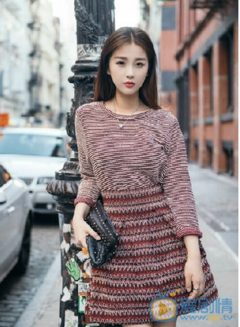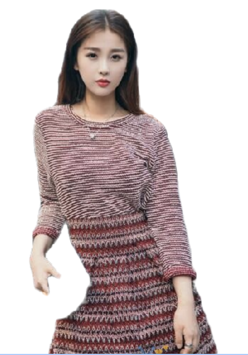目标
paddlehub项目链接:https://aistudio.baidu.com/aistudio/projectdetail/437104
PaddleHub DeepLabv3+模型(deeplabv3p_xception65_humanseg)实现一键抠图
实现功能
1.实现单张小姐姐图片的抠图(背景替换)
2.实现对视频的抠图(背景替换)将红昭愿的视频更换为宇宙背景
实现思路
功能1:
单张图片抠图采用paddlehub真的是一键抠图呀。
#安装1.6的paddlehub
pip install paddlehub==1.6.0 -i https://pypi.tuna.tsinghua.edu.cn/simple -t /home/aistudio/external-libraries
import paddlehub as hub
# 待预测图片
test_img_path = ["./data/yu.jpg"]
import matplotlib.pyplot as plt
import matplotlib.image as mpimg
img = mpimg.imread(test_img_path[0])
# 展示待预测图片
plt.figure(figsize=(10,10))
plt.imshow(img)
plt.axis('off')
plt.show()
待抠图的图片:

#加载paddlehua提供的人脸分割的模型
module = hub.Module(name="deeplabv3p_xception65_humanseg")
#paddlehub的所有输入必须要是一个字典格式的data,并且字典里面的内容要是一个list
input_dict = {"image": test_img_path}#传入也必须是个字典,字典的value必须是个list
# execute predict and print the result使用模型得到结果
results = module.segmentation(data=input_dict)
for result in results:
print(result)#打印结果
# 预测结果展示
test_img_path = "./humanseg_output/yu.png"
img = mpimg.imread(test_img_path)
plt.figure(figsize=(10,10))
plt.imshow(img)
plt.axis('off')
plt.show()
抠图结果:

可以发现,前面的街道背景已经没有了。对于各种情况下的真人扣取都试试了一下,发现效果都挺好的。下面是模型的实现结果
模型结果对比

背景替换函数:
#图像合成函数
from PIL import Image
import numpy as np
#blend 混合
def blend_images(fore_image, base_image,savepath):
"""
将抠出的人物图像换背景
fore_image: 前景图片,抠出的人物图片 为png格式 会多一个通道
base_image: 背景图片
savepath:图片要保存的路径,图片保存的文件名和前景图片的名字一样
"""
# 读入图片
fore_image_dir = fore_image
base_image = Image.open(base_image).convert('RGB')#如果是png可能多了一个A通道
fore_image = Image.open(fore_image).resize(base_image.size) #将前图缩放背后景图一样大小
# 图片加权合成
scope_map = np.array(fore_image)[:,:,-1] / 255
scope_map = scope_map[:,:,np.newaxis] #np.newaxis 为 numpy.ndarray(多维数组)增加一个轴
scope_map = np.repeat(scope_map, repeats=3, axis=2)
res_image = np.multiply(scope_map, np.array(fore_image)[:,:,:3]) + np.multiply((1-scope_map), np.array(base_image))
#保存图片
res_image = Image.fromarray(np.uint8(res_image))
save_path = os.path.join(savepath, os.path.basename(fore_image_dir))
res_image.save(save_path)

功能2:视频换背景
实现的思路:
因为paddlehub的模型的喂数据的问题,所有不能直接喂视频,需要传入一个字典,字典里面需要是一个list的数据。
1.先读取视频,使用opencv按帧读取转为为图片
# video 2 images
###step1
def extract_images(src_video, dst_dir):
'''
src_video:为目标的视频文件地址
dst_dir:为视频图片的保存路径
'''
video = cv2.VideoCapture(src_video)
count = 0
while True:
flag, frame = video.read()
if not flag:
break
cv2.imwrite(os.path.join(dst_dir, str(count) + '.png'), frame)
count = count + 1
print('extracted {} frames in total.'.format(count))
2.对1中最后得到的的所有图片进行人物抠图
###step2
def manSeg(img_path,out_dir):
# test images
test_image_list = [os.path.join(img_path, img_name) for img_name in os.listdir(img_path)]
# segment images!
input_dict = {"image": test_image_list}
module.segmentation(data=input_dict,output_dir = out_dir)
3.对2中最后得到的所有图片与背景图片进行合成
# blend images
def blend_vides(input_dir,base_image,save_dir):
index = 0
for img in os.listdir(input_dir):
print('总共{}张,处理到了{}张图片'.format(len(os.listdir(input_dir)),index+1))
fore_image = os.path.join(input_dir,img)
blend_images(fore_image, base_image, save_dir)
4.将3中合成的所有图片合成为视频
# image2video
#将扣图和背景组合的图片从新合成为视频(
def img2video(dst_video_path,pic_path,size,frame):
'''
dst_video_path:合成视频的路径
pic_path:合成的所有图片的路径
size:图片的大小,即是视频的大小
frame:帧率
VideoWriter_fourcc为视频编解码器
fourcc意为四字符代码(Four-Character Codes),顾名思义,该编码由四个字符组成,下面是VideoWriter_fourcc对象一些常用的参数,注意:字符顺序不能弄混
cv2.VideoWriter_fourcc('I', '4', '2', '0'),该参数是YUV编码类型,文件名后缀为.avi
cv2.VideoWriter_fourcc('P', 'I', 'M', 'I'),该参数是MPEG-1编码类型,文件名后缀为.avi
cv2.VideoWriter_fourcc('X', 'V', 'I', 'D'),该参数是MPEG-4编码类型,文件名后缀为.avi
cv2.VideoWriter_fourcc('T', 'H', 'E', 'O'),该参数是Ogg Vorbis,文件名后缀为.ogv
cv2.VideoWriter_fourcc('F', 'L', 'V', '1'),该参数是Flash视频,文件名后缀为.flv
cv2.VideoWriter_fourcc('m', 'p', '4', 'v') 文件名后缀为.mp4
'''
dst_video = cv2.VideoWriter(dst_video_path, cv2.VideoWriter_fourcc(*'mp4v'), frame, size, True)
for index in range(len(os.listdir(pic_path))):
frame = cv2.imread(os.path.join(pic_path,'{}.png'.format(index)))
dst_video.write(frame)
dst_video.release()
5.给4中得到的视频添加bgm
def add_audio(s_video_path,d_video_path):
video_s = VideoFileClip(s_video_path)
video_d = VideoFileClip(d_video_path)
audio_o = video_s.audio
video_dd = video_d.set_audio(audio_o)
video_dd.write_videofile(d_video_path[0:d_video_path.rfind('/')+1]+'hong_audio.mp4')
主函数:
def change_video_bk():
##1.将视频按帧提取出图片image_list
src_video = './work/video/hong-withaudio.mov'
dst_dir = './work/video-imgs'
checkdir(dst_dir)#如果不存在就创建,存在就清除里面内容 check1
#function1
extract_images(src_video, dst_dir)
##2.对image_list所有的图片进行抠图,然后更换背景保存图片得到processed_image_list
out_dir = './work/video-seg_out'
checkdir(out_dir) #check2
#function2.1
manSeg(dst_dir,out_dir)
base_image = './work/img/sea.jpg'
save_dir = './work/video-imgs'
checkdir(save_dir) #check3
#function2.2
blend_vides(out_dir,base_image,save_dir)
#3.将processed_image_list中的所有图片组成为video
save_dir = './work/video-imgs'
base_image = './work/img/sea.jpg'
result_video_dir = './work/video-result/'
checkdir(result_video_dir) #check4
result_video_name = os.path.join(result_video_dir,'hong.mp4') #最终输出的视频的名字
size = Image.open(base_image).size
frame_size = 25
#function3 图片合成为视频
img2video(result_video_name,save_dir,size,frame_size)
#function4 给视频加上bgm
add_audio(src_video,result_video_name)
























 488
488











 被折叠的 条评论
为什么被折叠?
被折叠的 条评论
为什么被折叠?








